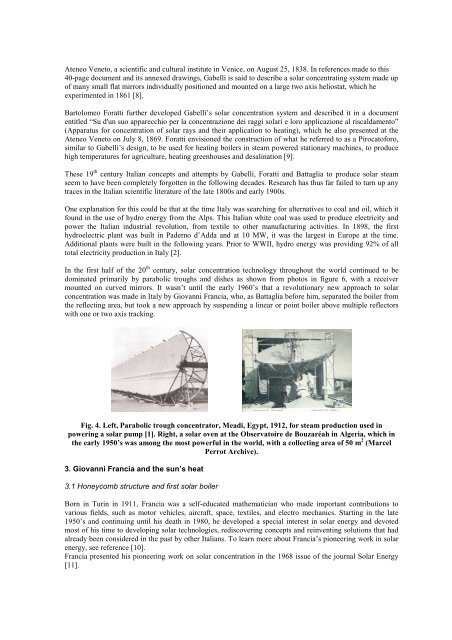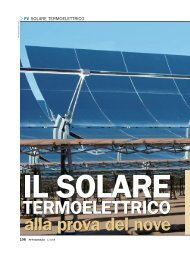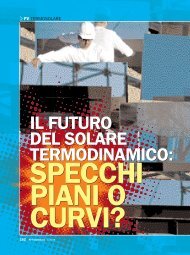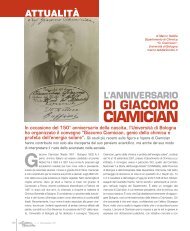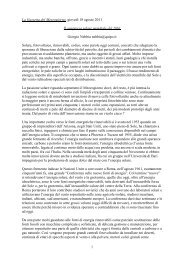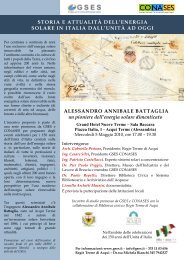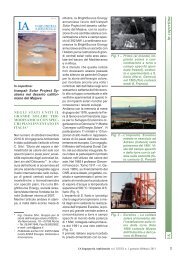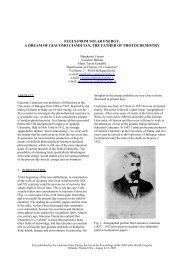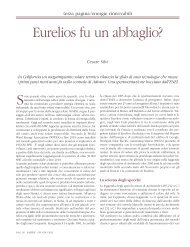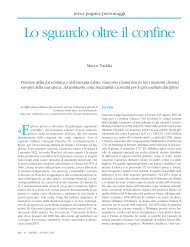The Pioneering Work On Linear Fresnel Reflector ... - GSES
The Pioneering Work On Linear Fresnel Reflector ... - GSES
The Pioneering Work On Linear Fresnel Reflector ... - GSES
You also want an ePaper? Increase the reach of your titles
YUMPU automatically turns print PDFs into web optimized ePapers that Google loves.
Ateneo Veneto, a scientific and cultural institute in Venice, on August 25, 1838. In references made to this<br />
40-page document and its annexed drawings, Gabelli is said to describe a solar concentrating system made up<br />
of many small flat mirrors individually positioned and mounted on a large two axis heliostat, which he<br />
experimented in 1861 [8].<br />
Bartolomeo Foratti further developed Gabelli’s solar concentration system and described it in a document<br />
entitled “Su d'un suo apparecchio per la concentrazione dei raggi solari e loro applicazione al riscaldamento”<br />
(Apparatus for concentration of solar rays and their application to heating), which he also presented at the<br />
Ateneo Veneto on July 8, 1869. Foratti envisioned the construction of what he referred to as a Pirocatoforo,<br />
similar to Gabelli’s design, to be used for heating boilers in steam powered stationary machines, to produce<br />
high temperatures for agriculture, heating greenhouses and desalination [9].<br />
<strong>The</strong>se 19 th century Italian concepts and attempts by Gabelli, Foratti and Battaglia to produce solar steam<br />
seem to have been completely forgotten in the following decades. Research has thus far failed to turn up any<br />
traces in the Italian scientific literature of the late 1800s and early 1900s.<br />
<strong>On</strong>e explanation for this could be that at the time Italy was searching for alternatives to coal and oil, which it<br />
found in the use of hydro energy from the Alps. This Italian white coal was used to produce electricity and<br />
power the Italian industrial revolution, from textile to other manufacturing activities. In 1898, the first<br />
hydroelectric plant was built in Paderno d’Adda and at 10 MW, it was the largest in Europe at the time.<br />
Additional plants were built in the following years. Prior to WWII, hydro energy was providing 92% of all<br />
total electricity production in Italy [2].<br />
In the first half of the 20 th century, solar concentration technology throughout the world continued to be<br />
dominated primarily by parabolic troughs and dishes as shown from photos in figure 6, with a receiver<br />
mounted on curved mirrors. It wasn’t until the early 1960’s that a revolutionary new approach to solar<br />
concentration was made in Italy by Giovanni Francia, who, as Battaglia before him, separated the boiler from<br />
the reflecting area, but took a new approach by suspending a linear or point boiler above multiple reflectors<br />
with one or two axis tracking.<br />
Fig. 4. Left, Parabolic trough concentrator, Meadi, Egypt, 1912, for steam production used in<br />
powering a solar pump [1]. Right, a solar oven at the Observatoire de Bouzaréah in Algeria, which in<br />
the early 1950’s was among the most powerful in the world, with a collecting area of 50 m 2 (Marcel<br />
Perrot Archive).<br />
3. Giovanni Francia and the sun’s heat<br />
3.1 Honeycomb structure and first solar boiler<br />
Born in Turin in 1911, Francia was a self-educated mathematician who made important contributions to<br />
various fields, such as motor vehicles, aircraft, space, textiles, and electro mechanics. Starting in the late<br />
1950’s and continuing until his death in 1980, he developed a special interest in solar energy and devoted<br />
most of his time to developing solar technologies, rediscovering concepts and reinventing solutions that had<br />
already been considered in the past by other Italians. To learn more about Francia’s pioneering work in solar<br />
energy, see reference [10].<br />
Francia presented his pioneering work on solar concentration in the 1968 issue of the journal Solar Energy<br />
[11].


